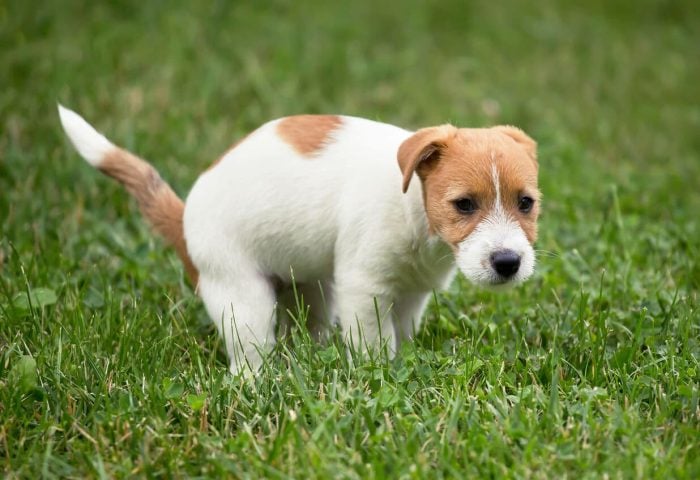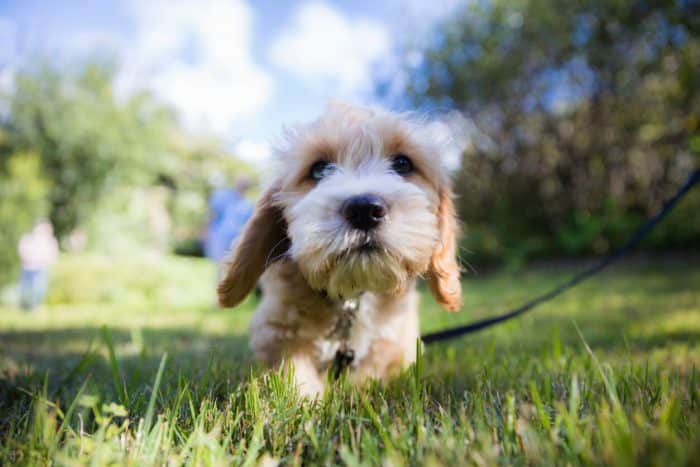- Not a substitute for professional veterinary help.
Some days, your dog might be ready to do their business at the drop of a hat. But on the days it takes them longer to find the best spot, you can try a few tricks to help them poop quickly.
Dogs have a lot of bathroom rituals, from circling, sniffing, even spinning before they find the right place. Afterward, they might sniff their poop and kick dirt over it. These habits, ultimately, all help dogs feel more comfortable pooping.
Yet even though you might wish you had all the time in the world to wait for your dog to choose the perfect place to go, you probably don’t always have time to wait. So while you may not want your dog to feel rushed, you might still need to speed their process along.
“Motivating dogs to poop faster can be safe, healthy, and comfortable if done properly,” says Dr. Lindsay Butzer, DVM, PetMeds Partner. “It can benefit both the dog and the pet parent in certain situations, like if a dog needs to relieve themselves before a long car ride or if the pet parent has limited time for a walk.”
However, it’s important to not force a dog to poop faster on a regular basis, since this can disrupt their natural bodily functions and potentially cause stress or discomfort, she adds.
Read on to learn everything you need to know about how to help your dog poop quickly.
Why Do Dogs Take So Long To Poop?
A few reasons may help explain why dogs take a long time to poop, from personal preferences to health conditions.
Location
Irith Bloom, a CPDT-KSA certified professional dog trainer and behavior consultant, and owner of The Sophisticated Dog, explains why dogs might be fussy about where or when to poop.
“Like people, dogs may feel more or less comfortable with a particular ‘bathroom,’” she says. “A spot might be too smelly, or have the wrong smell, to be considered a good bathroom. Also, depending on a dog’s potty training history, the dog may not be used to a specific kind of environment.”
Bloom recommends paying attention to the areas where your dog tends to choose to poop and going there when you want them to do their business faster.
She adds that it can help for dogs to be able to go in a lot of different types of environments. When you have time, let them slowly explore so they can get used to pooping in different situations. This can help when you’re traveling, or if you move to a different home.
Health
“Some dogs naturally have faster or slower digestion, which can affect how quickly they eliminate waste,” Dr. Butzer says. “Additionally, certain medical conditions, such as gastrointestinal disorders or dietary intolerances, can also impact pooping speed. Stress, anxiety, or changes in routine can also affect a dog’s bowel movements.”
If you notice any changes in your dog’s poop or how often they go, talk to your vet. They can help rule out any potential health conditions.
They’re having a good time
Bloom says a lot of dogs may wait a while before doing their business because they’ve learned that as soon as they poop, the fun ends. In other words, you call for them to come inside or you wrap up the walk to head home.
If they want to stay out and keep walking or playing, they might delay their business for some extra time.
5 Tips To Help Dogs Poop
These tips can help shorten your dog’s bathroom breaks.
1. Add fiber
Adding fiber to your dog’s diet can help keep their bowel movements regular and prevent constipation and diarrhea. To increase the chance of your dog pooping faster, add it to their meal 30 minutes before a walk.
Dr. Butzer says canned pumpkin is a popular choice for adding fiber to a dog’s diet. Pumpkin can help regulate bowel movements and ease constipation. Other fiber-rich foods that can aid in the pooping process include sweet potatoes, green beans, and psyllium husk, she says.
Before switching over to a high-fiber dog food or introducing any new foods or fiber supplements to your dog’s diet, she recommends asking your vet to make sure it will meet your dog’s needs.
2. Try a pre-walk belly massage
Gently massaging your dog’s abdomen can help relax the muscles in the digestive tract and promote better bowel function, Dr. Butzer says. She recommends giving your dog a belly massage about 10–15 minutes before going out for a walk. This allows enough time for the massage to take effect without causing any urgency during the walk itself.
Belly massages can also help soothe your dog and relieve discomfort or anxiety related to pooping, Dr. Butzer says. This may help dogs who had negative experiences or anxiety around pooping in the past.
3. Provide more exercise
Regular exercise helps regulate dogs’ digestive tracts and can improve pooping habits.
“Like people, some dogs need to do something active to get their system going, so to speak,” Bloom says. Activities and exercises that can promote faster pooping include playing fetch or running around with your dog before a walk, she adds.
Your dog’s exercise needs will depend on their age, breed, health status, and individual needs. Some dogs may just need a short daily walk or two, while others may need a combination of play sessions and physical activity.
If your dog loves a certain exercise or game, spend some time getting them excited and active before they go out to help get their bowels moving.
When planning new exercises and activities, just make sure to consider your dog’s age and breed, especially if they’re a puppy, senior, or brachycephalic breed. Your vet can offer more guidance on the ideal amount of exercise for your dog.
4. Try pet wipes
You can use pet-safe wet wipes to gently rub a dog’s rear end if you need them to poop pronto. Dr. Butzer says this may work on puppies since mother dogs lick them to get them to poop. However, it may not work on adult dogs all the time.
She also cautions against rubbing a dog’s anus with a wipe too often, since this can cause irritation. (Though with some dogs, you may need to use wet wipes regularly to clean up any poop that gets stuck on their butt as it comes out, Dr. Butzer says.)
If you want to try this method, use wipes specifically made for pets. In a pinch, you can also use fragrance-free baby wipes, but it’s best to stick with pet wipes.
5. Try training
If your dog is housetrained, you can encourage them to poop faster through training.
Bloom breaks down the steps to helping dogs poop a little faster:
- Play with your dog indoors to make sure they’ve had enough activity to get their gastrointestinal tract moving.
- Leash your dog and go straight to a spot in the yard where your dog likes to poop.
- Stay in that particular spot for about 5 minutes, acting as boring as possible. In other words, don’t interact or engage with your dog.
- If your dog poops, praise them and give them off-leash time in the yard or take them for a walk.
- If they don’t poop, take them back indoors and try again in about 15 or 30 minutes.
Bloom says this method only works if your dog is already fundamentally housetrained. If your dog is not yet housetrained, she recommends confining them to a crate and only waiting about 10 minutes between potty opportunities of 5 (boring) minutes each.
Does Your Dog Really Need to Poop Quicker?
Dr. Butzer says it’s generally best to allow dogs to go at their own pace when it comes to pooping. Of course, there may be scenarios where encouraging quicker pooping is more beneficial or even necessary.
“For example, if a dog has signs of discomfort or urgency due to an upcoming event or medical condition, gently encouraging them to eliminate waste can be appropriate,” she explains.
Bloom says that from a behavioral point of view, she believes it’s good for a dog to be able to poop promptly since some life circumstances may mean you can’t wait very long for them to defecate. For example, in some situations your vet may ask you to limit their physical activity.
Pros and cons
Dr. Butzer explains a few potential benefits and drawbacks of expediting the pooping process:
Benefits
Getting your dog to poop faster can add convenience for you, especially in situations where time is limited or when traveling. It can also provide dogs experiencing discomfort or urgency with some relief.
Drawbacks
Rushing your dog can disrupt the natural rhythm of their bowel movements, which can potentially lead to digestive issues or stress.
“It’s important to find a balance between respecting your dog’s natural rhythm and addressing any specific needs or time constraints,” Dr. Butzer says.
How To Tell If Your Dog Is Constipated
If your dog is taking longer than usual to poop, they may be constipated.
Signs of constipation in dogs include:
- Straining to defecate
- Producing dry or hard stools
- Fewer bowel movements
- Signs of discomfort or pain while trying to poop
- Scooting
- Decreased appetite
- Vomiting
Dr. Butzer explains that it’s not always easy to recognize the difference between fussy pooping behaviors and potential constipation issues.
If your dog has signs of constipation or can’t pass any stool at all, make an appointment with your vet right away. They can examine your dog, find possible causes of constipation, and recommend helpful treatments.
These tips can help prevent and relieve constipation in dogs:
- Provide fresh water at all times to help them stay hydrated.
- Help them get enough exercise to stimulate bowel movements.
- Feed them a balanced, fiber-rich diet.
Avoiding sudden dietary changes and providing a consistent routine can also help your dog have regular and healthy bowel movements.
If your dog is prone to constipation, Dr. Butzer suggests talking with your vet for recommendations on specific dietary supplements, like probiotics, or adjustments to their diet.
Your dog can’t tell you how they feel, so understanding their typical behavior—and listening for any stomach noises—can help you recognize when something’s not right.
Takeaway
A pet parent’s life can get hectic! But taking care to carve out enough time in your routine for regular daily walks can help you avoid the need to speed up your dog’s potty breaks regularly.
Of course, those long walks can also provide even more time to savor every moment with your furry best friend.





